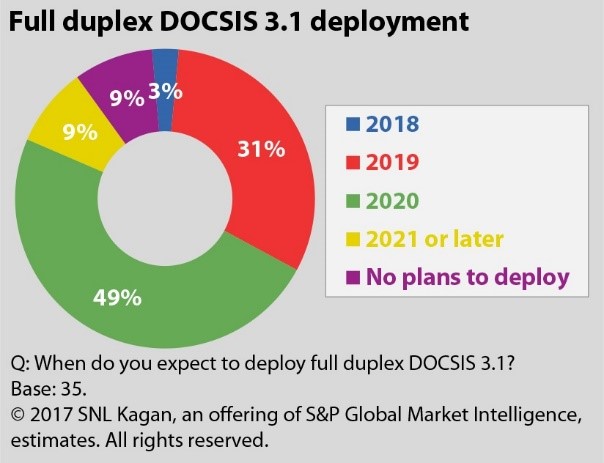Featured Topics
Featured Products
Events
S&P Global Offerings
Featured Topics
Featured Products
Events
S&P Global Offerings
Featured Topics
Featured Products
Events
S&P Global Offerings
Featured Topics
Featured Products
Events
Financial and Market intelligence
Fundamental & Alternative Datasets
Government & Defense
Banking & Capital Markets
Economy & Finance
Energy Transition & Sustainability
Technology & Innovation
Podcasts & Newsletters
Financial and Market intelligence
Fundamental & Alternative Datasets
Government & Defense
Banking & Capital Markets
Economy & Finance
Energy Transition & Sustainability
Technology & Innovation
Podcasts & Newsletters
31 Oct, 2017 | 09:00

By Jeff Heynen
With 1 Gbps services via DOCSIS 3.1 already on the short-term horizon, cable operators aren’t wasting any time planning for a world where 10 Gbps will be the norm. Full duplex, or FDX, DOCSIS 3.1, which can deliver symmetric 10 Gbps speeds over existing coaxial cable, is moving quickly through the standardization process, with CableLabs recently releasing the physical, or PHY, layer specifications for the technology. This is a critical step in providing guidance to component and system vendors ready to design and build products with FDX capabilities.
Beyond the overall throughput increase, the biggest benefit FDX offers is the ability to deliver symmetric speeds. Unlike current DOCSIS specifications, which require that spectrum be split for use in either the upstream or downstream directions, FDX introduces the idea of “dual-use” bands for traffic running in both directions. By allowing the upstream and downstream traffic to concurrently use the same spectrum, cable operators can double the efficiency of their spectrum and push symmetric speeds to 10 Gbps without having to move to full fiber-to-the-home, or FTTH.
Per the released specifications, the FDX band will reside between 108 MHz and 684 MHz, which means that the technology will be fully compatible with DOCSIS 3.1 customer premises equipment, or CPE. Backwards-compatibility is a critical piece to the success of FDX, because the technology will require operators to push fiber extremely deep into their networks, ultimately moving to a node + 0 architecture, where no additional amplifiers are used between the optical node and the end customer. Cable operators are already moving in that direction, as they pursue distributed access architectures, such as remote PHY, or R-PHY, and remote media access control PHY, or R-MACPHY, whereby core functions of the headend-based converged cable access platform, or CCAP, are distributed closer to end customers in hub sites or optical nodes. Over time, these remote node-based implementations can essentially be transformed into FDX-capable nodes, delivering the symmetric 10 Gbps services their telco and ISP competition can deliver with more expensive FTTH architectures.
A survey of 35 global cable operators regarding plans for FDX deployments, completed earlier this year by Kagan, a media research group within S&P Global Market intelligence, showed that nearly 50% of respondents expect to deploy FDX in 2020, with 31% saying they will deploy the technology in 2019.
These expectations are very realistic and appear in line with the expected product development cycle. In 2018, we will see the development of both chips and systems capable of delivering FDX services, followed by early trials and some live deployments in 2019.
The key takeaway from these survey results is that cable operators have a clear technology roadmap in front of them to get to symmetric 10 Gbps speeds without having to trench fiber to every subscriber’s home. They can continue to maximize their hybrid fiber coaxial, or HFC, networks and not have to replace existing CPE and set-top boxes.
